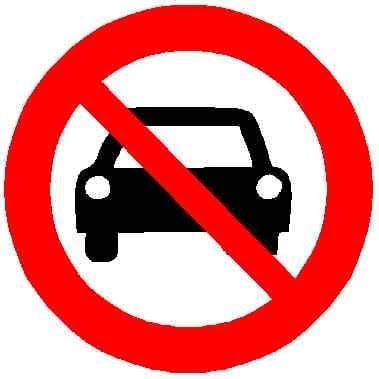“Giving people more viable alternatives to driving means more people will choose not to drive, so there will be fewer cars on the road, reducing traffic for drivers.”
Concise, easy to understand, and accurate. I have used it at least a dozen times and it is remarkable how well it works.
Also—
“A bus is about twice as long as a car so it only needs to have four to six passengers on board to be more efficient than two cars.”


That’s great for you, as an individual, but the fact is that that same pattern of distance vs. affordability holds true all over the U.S. Actually, I mean distance vs. cost. Here where I live, housing gets cheaper further from the central city, but the economic and population growth is still pushing the cost up out of the affordable range even for the “cheap” stuff.
When I worked at the local grocery, I had a cheap apartment because of long tenure and luck. All of my co-workers, though, commuted in from outlying communities. Not only did they pay half of their income in rent, but then they had car expenses on top of it.
Land is more expensive in city. That’s reality whether or not cars exist. When the city removed parking requirements housing and real estate costs continued to rise at the same or greater rates, except now landlords could charge an additional $400 a month for a parking spot as well since it became a luxury instead of a right for their renters.
The reality is when you live somewhere as spaced out as the US, owning a car is a requirement unless you want to essentially return to a feudalist system where people have to stay within a few miles of their homes for their entire lives while giving all their money to the landlord.
Hahaha, that is an amazing bifurcation fallacy! Cars or feudalism. Amazing then that Americans settled a whole continent without cars.
That aside, the truism in real estate is that the three most important characteristics of a property are: location, location, and location. Land in cities is always more expensive because its value is very closely tied up with the things it’s close to. In that sense, auto-oriented development is a massive theft of value, because everything in cities has to be further apart than it otherwise would be, in order to accommodate wide streets, and parking spaces.
Less philosophically, “more expensive” is a scale, not an absolute condition. If all of that space currently devoted to speedy car travel in cities were instead available for people to live in, yes, the central city would be the highest demand, and the most expensive. But the spatial scale of cost would be very different. My grocery store co-workers would still live on the edges, but the edges could be only a mile or two away, not 15 miles away. That, and lots of cities wouldn’t be structurally insolvent due to all the infrastructure they need to pay for.
(That last bit is a sore point for me, as city is facing a $22 million budget deficit, and they’re considering cutting things like emergency services, or even the municipal pool. While the water utility shores up century-old pipes, we’re still subsidizing the parking utility.)
If you buy a new couch, how do you get it to your door? A truck.
If someone has a great attack, what do you call for? An ambulance.
99% of the road infrastructure requirements we have with developers aren’t about minimum parking or sprawl, but about having minimum leave sizes and turning radius for fire trucks.
Even if personal vehicles weren’t a thing, we’d still need most of the road infrastructure we have to move goods and services and provide access for emergency vehicles. Adding parking spaces over subgrade detention where the weight of a building can’t be located anyway doesn’t significantly spread things out.
The chief generators of traffic here are the high cost of land in cities, the dangerous heat levels (people who aren’t in shape, children, and the elderly can be killed by a 15-minute walk in the summer), and the insane focus on in-person office work.
I had to come into the office a few times during the lockdown, and my commute was reduced by an hour each way. Most of the people working from home during that time should still be working from home today. It would solve the traffic and real estate issues by giving people the freedom to live where they want.
Saying “cars bad” and thinking that’s a solution screams of living in a fantasy world. Get a degree in planning them go work in an area where we have these problems and you’ll quickly learn that it can’t be solved by city planning.
We don’t spend decades working on these problems and then increase the lane count because we’re lazy. We do it because it’s the only thing we can do that alleviates any issues.
This to me comes across as reaching: It’s easy to design streets that are for people, but accommodate the occasional delivery vehicle, or ambulance. (A standard ambulance is only about 8 feet wide.) How often are people buying new couches or having heart attacks, anyway? We also don’t need most of the road infrastructure for transport of goods, and service vehicles. Every city street, county road, state highway, or Interstate highway that I’ve ever driven on, anywhere, has a vast majority of consisting of personal vehicles, with the exception of I-80/94 through Gary, Indiana. Freight-carrying trucks aren’t even allowed in the 3rd, left-most lane most of the time. Suburban streets are crazy wide; much wider than needed for freight delivery, or even the large units that fire officials insist upon. Smaller fire trucks exist, too, and are very effective where they are used. And, even if subgrade detention is the best solution in a particular situation, something like, say, a park can go on top, and offer much better infiltration than a parking lot. I know of stormwater vaults in large buildings, so they don’t necessarily preclude buildings on a site. In any case, how many parking lots have a detention basin underneath?
Lastly, you’re severely misrepresenting my point of view by comparing to wailing, “cars bad,” and thinking that’s a solution. No, I look to solutions that cities around the world (including my own, in some limited cases) have actually, successfully implemented. Adding lanes is the only politically viable solution sometimes, but it mostly just makes the problems worse in the long-run.
Suburban streets are literally designed around firetrucks. We make them design around allowing firetrucks to reach all houses without having to back out of the neighborhood. That’s why cul-de-sacs exist 90% of the time. They’re firetruck turnarounds.
The developers don’t*why to do this. They want 16ft roads with people folding their mirrors to pass each other so they can cram in more 1500 square foot houses they sell for a million dollars.
They also want zero green space, but we require impervious cover. Specifically, we limit IC to 25% because we’re in a recharge area for an aquifer. We also require water quality treatment of that 25%.
That’s generally what’s under a lot of the roads here. They do rooftop rainwater collection and storm drains that are piped to underground storage that discharges slowly to a retention pond through a jellyfish filtration system.
We allow the grass to treat water naturally where we can and put the storage under the pavement.